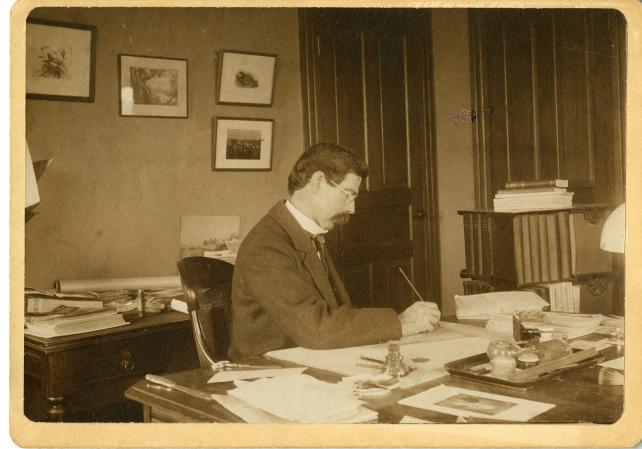Results for "Rich people"
- Webpage
Jesse Walter Fewkes
- Date: April 4, 2017
- Description: [view in Spanish][edan-image:id=siris_arc_290975,size=200,left]Born in Newton, Massachusetts, his scientific career is divided into two distinct research fields and time periods. The first deals with marine zoology and the last with anthropology. Fewkes received a Ph.D. in marine zoology from Harvard in 1877, and was curator of lower invertebrates at the Museum of Comparative
- Blog Post
The Anniversary of the National Museum of African Art: A Gift in August
- Date: August 13, 2012
- Creator: Mitch Toda
- Description: On August 13, 2012 the National Museum of African Art, founded by Warren M. Robbins, became a part of the Smithsonian Institution.
- Smithsonian Legal Document
Smithsonian Institution, Board of Regents, Minutes, 1846
- Date: 1879 December 3, 1846
- Creator: Board of Regents
- Creator: Board of Regents

International Migratory Bird Day
- Date: May 5, 2015
- Creator: Effie Kapsalis
- Description: To celebrate International Migratory Bird Day on May 9th, we will be releasing recently digitized specimen drawings by ornithologist Robert Ridgway (1850-1929.) Ridgway's career with the Smithsonian began in 1864 when he wrote asking for help identifying a bird. As they say, the rest is history. Starting in 1869, Ridgway became curator at the Smithsonian's United States

An Intern Learns from Those Who Came Before
- Date: August 16, 2016
- Description: A brief tale of a Smithsonian summer internship and the experience, knowledge, and change that ensued.
- Webpage
Carlos de la Torre y la Huerta
- Date: April 4, 2017
- Description: [view in Spanish][edan-image:id=siris_arc_296726,size=200,left]Carlos de la Torre y la Huerta was the foremost Cuban naturalist of his era, following in the footsteps of Felipe Poey. De la Torre was a naturalist of the old school, with broad interests in natural history. He focused his research on mollusks, both living and paleontological specimens. He collaborated for many
- Webpage
Maria do Carmo Bandeira
- Date: April 4, 2017
- Description: [view in Spanish]Doña María do Carmo Bandeira was a botanist with the Jardim Botanico de Rio de Janeiro, specializing on mosses. She served on the editorial board of its Arquivos do Jardim Botanico do Rio de Janeiro. In the late 1920s, she established a correspondence with Mary Agnes Chase, curator of grasses in the U.S. National Museum. They exchanged plant specimens and
- Webpage
Sharing Plants, Animals, and Friendships
- Date: April 18, 2017
- Description: [view in Spanish][edan-image:id=siris_sic_9227,size=110,left]Exchanging specimens is essential in botanical research: Herbaria swap their duplicates in return for specimens they lack. Such international trading is based on relations established through correspondence and research trips, relations that endure through generations of botanists. By the early twentieth century,
- Finding Aid
SIA Acc. 02-063, Freer Gallery of Art and Arthur M. Sackler Gallery Office of Education, Audiovisual Records, 1954, 1972, 1990-1993, and undated
- Date: 1954 1954-1993 1954, 1972, 1990-1993, and undated
- Creator: Freer Gallery of Art and Arthur M. Sackler Gallery. Office of Education
- Creator: Smithsonian Institution Archives
- Webpage
Exploration of the Southern Continent
- Date: April 4, 2017
- Description: [view in Spanish][edan-image:id=siris_sic_13396,size=150,left]Much of the Smithsonian's early natural history collections came from Mexico, the Caribbean, and Central and South America. The fourth Annual Report (1850) discusses several Latin American expeditions, in particular the exploration of islands near Nicaragua by Ephraim G. Squier, who served as U.S. charge d'affaires
War Correspondents
- Date: July 26, 2012
- Creator: Pamela M. Henson
- Description: Discusses the opening of an exhibit When Time and Duty Permit: Smithsonian Collecting in World War II and the correspondence files that will be displayed.
Field Notes Wikipedia Edit-a-Thon
- Date: June 27, 2013
- Creator: Effie Kapsalis
- Description: This is a summary of the Smithsonian Institution Archives' 3rd Wikipedia edit-a-thon on the scientific field books in the Archives’ collections
